FILMS
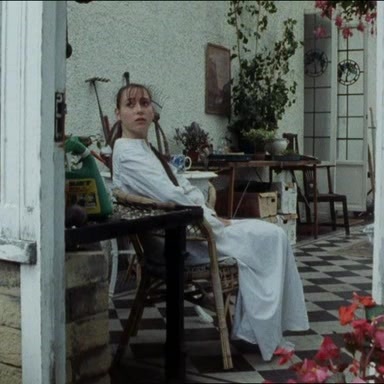
Girl from the South
1988, 84 mins
Poor little rich girl into Mills & Boon fantasies falls for unemployed black boy up north and tries to ‘help’. Festivals: Finland, Germany, Canada, Australia, Prix du CIJEF (sponsored by UNESCO) in Laon, France, 1990. Sold world¬wide for TV.
ANNE is the daughter of well-to-do parents in the South of England. Like many young girls of her age, she reads romances and, on a trip to her grandparents in the North, she decides to write her own story and live it out at the same time. So, one morning, bored with Granny's attempts to entertain her, she leaves the safety of the rich suburbs and sets out towards 'the poorer part of town' determined to meet her own real-life, tall dark stranger. Walking up a street of back-to-back houses – and still in her daydream – ANNE bumps into an old woman (GRANNY WHITE), sending her shopping flying. A lucky accident as the old woman's grandson, RALPH, turns out to be exactly the boy she is looking for... well, nearly – he does have a strange penchant for art galleries and Elgar. But ANNE doesn't only fall in love. Discovering that not everyone is as rich as her, she determines to balance things out by persuading RALPH to take part in an unusual form of burglary. She assures him that if things go wrong, she will own up and say it was her fault. "They'll never believe you!" says Ralph. And they don't.
GENERAL INFORMATION
Company: Cori Films/ Spectre Productions
Country: United Kingdom
Type: 16mm Colour Fiction Feature Film
Topic: Romantic teenage rich girl from South falls for poor black boy in North.
Available as: DVD or other digital format.
Available from: Yorkshire Film Archive (yfa@yorksj.ac.uk.
CREW
Director: Richard Woolley
Script: Richard Woolley
Production: Jean Stewart
Camera: Janet Tovey
Sound: Bruno Heller/Soma
Music: Adrian Rhodes
CAST
Alan Thompson......Grandfather
Daphne Oxenford......Grandmother
Keith Weinstein......Lance
Mark Crowshaw......Ralph
Michelle Mulvaney......Anne
Rosamund Greenwood......Granny White
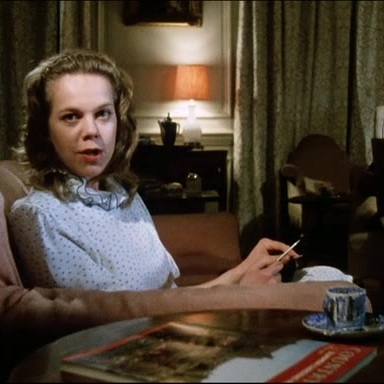
Waiting for Alan
1984, 45 mins
Sonata form drama centred on ritualised boredom of a middle-class housewife. Shown on CH 4 in Feb l987 & April 199O. Broadcast in Sweden, Germany, Holland and Canada.
WAITING FOR ALAN is about a woman whose marriage is dead. Trapped in the rich but sterile environment of a lavishly appointed country house, MARCIA is a microcosm of society – a victim of, and partner in, someone else's routine. It’s not the housework or the cooking (MRS BETTS looks after those), but the daily monotony of waiting for ALAN – her newspaper-reading, TV watching husband. To him, she's just the emotional central heating switched on and off in return for paying the bills and expected to operate as smoothly and regularly as the washing-up machine or the gardener. But MARCIA has waited long enough… WAITING FOR ALAN is a humorous but critical 'tale of the unexpected' (and expected) in classical, three-movement sonata form. It was screened at least twice on Channel Four television in the late eighties and both times received a very positive audience response as well as praise from weekly pre-viewers in the newspapers.
GENERAL INFORMATION
Company: Telltale Films/Channel Four
Country: United Kingdom
Type: 16mm Colour Film Drama
Topic: Lonely housewife determines to break husband’s boring routine
Available as: DVD or other digital format
Available from: Yorkshire Film Archive (yfa@yorksj.ac.uk)
CREW
Director: Richard Woolley
Script: Richard Woolley
Camera: Russell Murray
Sound: Moya Burns
Dubbing: Alf Bower
Music: Beethoven, Satie, Chopin – performed by Gerald Wragg
CAST
Anthony Schaeffer......Alan
Carolyn Pickles......Marcia
Mrs Betts......Joyce Kennedy
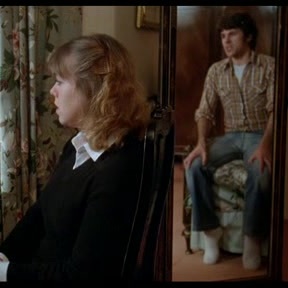
Brothers and Sisters
1981, 96 mins
Alternative thriller about murder of a prostitute in a Northern city. Festivals included New York, Chicago, Berlin, Florence, Melbourne, Edinburgh and official British entry status at Moscow. Screened by Ch 4 in l984 and 1989 and broadcast on TV worldwide.
BROTHERS AND SISTERS is a very different kind of thriller – a provocative investigation of sexual violence and mores both inside and outside of film. When JENIFER COLLINS, a part time prostitute, is found murdered, two upper-class brothers become suspects. Neither have alibis and although political rhetoric divides DAVID BARRATT, a self indulgent 'revolutionary' living in a communal house, from his brother, James, a right wing army major, both men are linked by their shared sexual hypocrisy. James, it seems, prefers secret liaisons with prostitutes to sleeping with his wife. While David, who has been sneakily conducting an affair with Theresa, the dead woman's sister employed by James as a nanny, bleats that he has just been 'trying to work out new codes of sexual behaviour', when challenged by Tricia, his live-in lover.
"By a clever juggling of murder-thriller suspense and soap-opera naturalism, Woolley shrewdly anatomises Anglo-Saxon attitudes to sex and the sexes" Financial Times
"A continuously interesting picture, formally adroit and persuasively acted" The Observer
"Woolley has the rare gift of keeping you anxious to know what happens next" The Times
"The film achieves an unexpected immediacy with Carolyn Pickles giving an impressive performance..." Time Out
GENERAL INFORMATION
Company: British Film Institute
Country: United Kingdom
Type: 35mm Colour Feature film
Topic: Reflective thriller revolving around murder of prostitute in Northern city
Available as: 35mm, 16mm, DVD or other digital format (pending)
Available from: Yorkshire Film Archive (yfa@yorksj.ac.uk)
CREW
Director: Richard Woolley
Script: Richard Woolley and others
Production: Keith Griffiths/Peter Sainsbury
Line Producer: Jim Pearse
D.O.P.: Pascoe Macfarlane
Sound: Alf Bower
Editing: Mick Audsley
Dubbing: Doug Turner (Delta Sound)
Music: Trevor Jones
CAST
Carolyn Pickles......Theresa Bennett/ Jennifer Collins
Elizabeth Bennett......Sarah Barratt
Jenifer Armitage......Tricia Snow
Robert East......James Barratt
Sam Dale......David Barratt
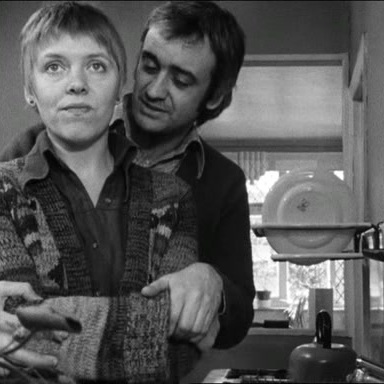
Telling Tales
1978, 90 mins
Looks at issues of gender and class. Screenings at festivals in Berlin, Edinburgh and London; widely shown in UK, Germany and elsewhere. Screened CH 4 TV in 1982.
TELLING TALES is about the failing marriage of an industrialist and his wife, about the industrialist's wish to sell his company to a colleague, Paul Roberts, and about the terminally ill wife of Paul, Ingrid. It is also about the shop steward organising a strike at Paul's factory that jeopardises the deal with the industrialist, and about the wife of the shop steward, who happens to clean and cook for the industrialist. A network of intertwined tales told in different ways, and for very different motives, by the main protagonists. Drawing on TV traditions of soap and serious drama, the manipulative emotionalism of a Hollywood weepy, the austerity of minimalism and the directness of Brecht, TELLING TALES both entertains the emotions and stimulates the intellect, making viewers aware of the act of viewing as well as letting them lose themselves in the viewed artefact; it draws them in with odd gobs of gaudy, conventionally-cut colour and spits them out with immaculately choreographed black & white single shot sequences. Born of the 1970's narrative deconstruction school, this is a unique gem of its time.
"This impressive film… boldly and illuminatingly tackles two of today’s most pressing problems: the relationship between women’s emancipation and class difference and the role of the media in preserving the status quo." Time Out
"One of the leading films from the independent cinema sector." TV Times
READ LONGER REVIEW (Scroll down to fourth item)
GENERAL INFORMATION
Company: Yorkshire Arts Association
Country: United Kingdom
Type: 16mm b&w/colour feature
Topic: Alternative drama playing with conventions of soap, tearjerker and stage
Available as: DVD or other digital format
Available from: Yorkshire Film Archive (yfa@yorksj.ac.uk)
CREW
Director: Richard Woolley
Script: Richard Woolley
Camera: Russell Murray
Lighting: Alf Bower
Sound: Moya Burns
Dubbing: Keith Hardy (Yorkshire Film)
CAST
Bridget Ashburn......Sheila Jones
James Woolley......Mr Willoughby/Paul Roberts
Patricia Donovan......Mrs Willoughby/Ingrid Roberts
Stephen Trafford......Bill Jones
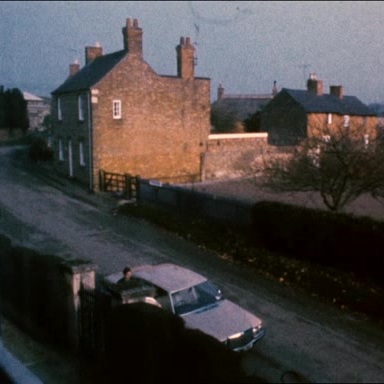
Illusive Crime
1976, 50 mins
Experimental narrative dealing with female oppression/class control. Controversial at time, especially among feminists.
Probably the most controversial of Woolley's films, because of an audio rape sequence with flashes of nudity that split critics and viewers (especially feminists) right down the middle – some saying it was exploitative, others saying it was essential to get the formalist message (that we are all voyeurs in the cinema, often viewing at the expense of women) across. The film tells the tale of a housewife (who we never totally see, but can hear) trapped in her luxury house at the mercy of a husband and ruthless police team investigating an illusory political crime that she may or may not have committed. Her husband (the only character we see in a conventional manner) comes in and out of the story and alternates between patronising solicitousness and cold anger. The whole is constructed around a relentlessly repetitive sequence of shots that, in the course of the film, moves ten times from wide shot exterior to intimate interiors, with the story being updated and narrated every time we return to the exterior. In each sequence, there is one POV handheld shot that varies and is usually from the wife's point of view; otherwise the story is told within the confines of the repeating images (same framing and camera movement) with only the action varying. Voiceovers narrate and reflect on a woman's position, as well as dominant male perspectives, in society.
"A serious and thorough artist, Woolley’s films collectively encompass all those issues which are at the centre of current critical debate: from the Straub-like impact of the deliberate camerawork and distanced acting and direct address in INSIDE AND OUTSIDE (DRINNEN UND DRAUSSEN) to the ironic narrative of ILLUSIVE CRIME and structural rigour of KNIEPHOFSTRASSE. Despite stylistic variety, these films are not pastiche, nor is Woolley a dilettante; rather his consistent concern has been to articulate image and sound through shifting relationships which challenge the very production of meaning through the conjunction of image/sound." Time Out
GENERAL INFORMATION
Company: Yorkshire Arts
Country: United Kingdom
Type: 16mm Colour (Kodachrome reversal) Experimental Fiction
Topic: Oppression and victimisation of wife by husband and police
Available as: DVD or other digital format
Available from: Yorkshire Film Archive (yfa@yorksj.ac.uk)
CREW
Director: Richard Woolley
Production: Richard Woolley
Sound: Richard Woolley
Editing: Richard Woolley
Dubbing: John Murray
Music: Richard Woolley
CAST
Amanda Reiss......Wife's Voice
Andrew Mcullough......Police Voice One
Colin Proctor......Police Voice Two
James Woolley......Husband
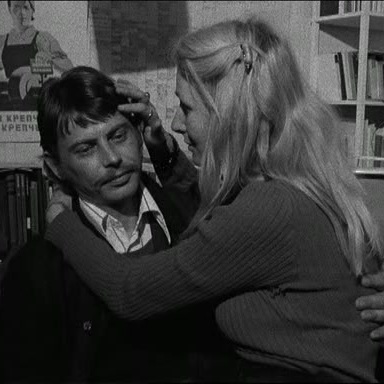
Drinnen und Draussen (Inside and Outside)
1974, 40 mins
Deals with filmic reality and conformity in East and West. Won acclaim at 1976 Edinburgh Festival.
A film set in the front room of a Berlin commune with a large shop window leading to the street outside. The film uses an actor and an actress, a pianist (visible playing the film's incidental music in the room next door) and occasional people on the street. Scripted action is located inside the room, unscripted on the pavement outside where passers-by occasionally stop and watch the actors in the same way that the audience is watching them on screen from a cinema or the comfort of home. The 'intellectual/ aesthetic' rationale for the film (in the director's words at the time) was to: "signify the similarity of social codes in East and West; to cement – seal with a kiss (there is a central scene where the actor and actress kiss in the traditional Hollywood manner) – two systems that, despite surface differences, seduce and cajole their citizens into obedience and passivity; to emphasise the common bond of bourgeois family values and traditional role-playing prevalent in consumer capitalist and state socialist countries." An ambitious agenda for a short film, but the serious (immaculately delivered) speeches and exchanges on personal/social positions and solutions are lightened by Woolley's tongue-in-cheek filmic observations and the comedic role of a pianist, who provides live musical comment and life-support in the room next door. The ending, where the inmates escape from their intellectual prison to the reality of the street outside, is a simple but effective critique of the obsessive search for theoretical answers to everything that hallmarked the early 70's.
"A serious and thorough artist, Woolley’s films collectively encompass all those issues which are at the centre of current critical debate: from the Straub-like impact of the deliberate camerawork and distanced acting and direct address in INSIDE AND OUTSIDE (DRINNEN UND DRAUSSEN) to the ironic narrative of ILLUSIVE CRIME and structural rigour of KNIEPHOFSTRASSE. Despite stylistic variety, these films are not pastiche, nor is Woolley a dilettante; rather his consistent concern has been to articulate image and sound through shifting relationships which challenge the very production of meaning through the conjunction of image/sound." Time Out
GENERAL INFORMATION
Company: DAAD (Deutsche Akademische Austauschdiesnt)
Country: Germany
Type: 16mm Black & White Experimental Fiction
Available as: DVD or other digital format
Available from: Yorkshire Film Archive (yfa@yorksj.ac.uk)
CREW
Director: Richard Woolley
Script: Richard Woolley
Production: Ulrike Hentrich-Wimmers
D.O.P.: Helmut Wietz
Sound: Klaus Schroeder
Dubbing: DFFB
Music: Mozart, Sibelius, Schubert (performed by Theo Hardtman)
CAST
Theo Hardtman......Pianist
Ulrike Pohl......Maedchen
Wolfgang W. Mueller......Junge
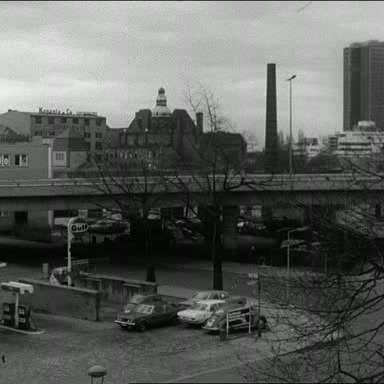
Kniephofstrasse
1973, 35 mins
Complex but compelling investigation of sound/image relationship shot in Berlin. Top prize at Knokke-le-Zoute film festival l975.
The most austerely structuralist and painterly of Woolley's films, KNIEPHOFSTRASSE, is based around a fixed camera single wide shot of a West Berlin townscape filmed at different times of day and night, at different speeds and in different weathers. The core wide shot image is also – in a rigorously systematic manner, starting from top left and moving to bottom right – subdivided into twenty equal-sized segments, each of which informs the wide shot in a different way (the close up of a car, man in snow, bare branches of a tree, etc). Added to this visual jigsaw is an endlessly changing palette of sounds, which influence and change the way we read the wide shot and subdivided segments. Some sounds are conventional (snippets of dialogue, incidental music, excerpts from a German TV soap or advertisement, wind in trees or the revving of a car) and some are abstract (a single dissonant organ note for each of the twenty segments, a sequence of repeated organ notes for the wide shot). The whole, despite its black and white austerity and the rigour of its schema, provides audiovisual stimulation and food for thought in a manner that is hard to find in an age of synthesizers and digital imaging. The use of a Bolex camera's stop-framing and slow motion capacity is just one example of a low-tech approach achieving unexpected and original high-end aesthetic effects.
"A serious and thorough artist, Woolley’s films collectively encompass all those issues which are at the centre of current critical debate: from the Straub-like impact of the deliberate camerawork and distanced acting and direct address in INSIDE AND OUTSIDE (DRINNEN UND DRAUSSEN) to the ironic narrative of ILLUSIVE CRIME and structural rigour of KNIEPHOFSTRASSE. Despite stylistic variety, these films are not pastiche, nor is Woolley a dilettante; rather his consistent concern has been to articulate image and sound through shifting relationships which challenge the very production of meaning through the conjunction of image/sound." Time Out
GENERAL INFORMATION
Company: DAAD (Deutsche Akademische Austauschdiesnt)
Country: Germany
Type: 16mm Black & White Experimental Film
Topic: Relationship between sound and image; perception of cinematic space
Available as: DVD or other digital format
Available from: Yorkshire Film Archive (yfa@yorksj.ac.uk)
CREW
Director: Richard Woolley
Script: Richard Woolley
Production: Brigitte Kleeblatt
Camera: Richard Woolley
Sound: Richard Woolley
Editing: Richard Woolley
Dubbing: DFFB
Music: Various

Freedom
1973, 1 min
Made for a competition in Chicago, man goes though his life – from forceps delivery birth to climbing into his own coffin – in one minute.
Film made as competition entry for Chicago Film festival. Theme was ‘Freedom’ and eventual winner (also from the Royal College of Art) had children circling in animated slow mo on a roundabout. Woolley’s entry was dark and pessimistic with a man’s life moving from forceps delivery, through bullying at school to climbing into a coffin. The late Robert East (also in Woolley’s ‘Brothers & Sisters’) went on to be one of Blackadder’s sidekicks in the first series.
GENERAL INFORMATION
Company: Royal College of Art
Country: United Kingdom
Type: Colour - experimental one minute competition film
Topic: Man moves from birth to death in one minute
Available as: DVD or other digital format
Available from: Yorkshire Film Archive (yfa@yorksj.ac.uk)
CREW
Director: Richard Woolley
Script: Richard Woolley
Camera: Richard Woolley
Sound: Richard Woolley
Editing: Richard Woolley
Music: Richard Woolley

Propaganda
1973, 10 mins
Man trapped in front of – and then inside – a television, as a Tory political broadcast swirls around him.
A TV screen displays a jumble of programmes in both real time and stop motion. The soundtrack mingles snippets of programmes, usually different from those on screen. At one point, after a political speech urging viewers to vote Conservative, a rousing song declaring that ‘times are changing’ turns out to be a jingle advertising glass. Amidst clips and flashes of TV static, a man appears on screen running towards the camera, shouting ‘Am I on the telly?’ Later, he approaches the camera and knocks on the lens/screen, ‘Am I in there?’ Each time he appears, he is increasingly insistent. Occasionally, another man appears in front of the TV, watching it, touching it and holding objects like scissors in front of it in silhouette. His movements are in stop-frame as is a moment when tape covers the screen spelling out the word, TV’. Final shot is of the Queen on the TV.
GENERAL INFORMATION
Company: Royal College of Art/Richard Woolley
Country: United Kingdom
Type: 16mm Black & White. Experimental short
Topic: Captivating and manipulative power of the television set.
Available as: DVD
Available from: Yorkshire Film Archive (yfa@yorksj.ac.uk)
CREW
Director: Richard Woolley
Script: Richard Woolley
Camera: Richard Woolley
CAST
Phil Mulloy

Ten Shots
1973, 10 mins
To show effect of sound on picture and how meaning can change, ten shots and ten sounds are repeated until correct sound matches correct picture.
Experimental short consisting of ten repeated shots set to deliberately mismatched sounds. The shots are: close-up of man’s eyes blinking; black shoes stepping back and forth; trees in a park; bells in church tower; torso of a person wearing a striped jumper and clapping his hands; cars on a city street; water pouring from a tap into a cup and overflowing; a nose and mouth mouthing; a person sitting on a bedroom floor, turning pages of a book; an empty glass smashed by a hammer. Never synchronised, the sounds that should match each shot are variously arranged to correspond with a different shot each time the sequence repeats. Occasionally, instrumental or choral music plays for the duration of one of the shots. Finally, after ten repetitions, image and sound synchronise.
GENERAL INFORMATION
Company: Royal College of Art/Richard Woolley
Country: United Kingdom
Type: 16mm Black & White Experimental Film
Topic: Proto music video that contrasts grey interior of a house with colour of its garden
Available as: DVD
Available from: Yorkshire Film Archive (yfa@yorksj.ac.uk)
CREW
Director: Richard Woolley
Script: Richard Woolley
Camera: Richard Woolley
Sound: Richard Woolley

Chromatic
1972, 6 mins
Clothed woman in exotic garden looks at herself trapped naked inside large country house. Extended music video (before genre really existed) to soundtrack by Jerry Garcia and Howard Whales.
Experimental short contrasting the grey interior of a house with the vibrant colour of its garden. Sunlight shines through leafy trees. The camera zooms in until the image is out of focus. When it zooms out again, it reveals sunlight through leaves reflected in the window of a house. From inside the house, we see a woman, in colour and fully dressed, walk by a window. Outside, the camera and photographer are seen in a mirror. The woman, in black & white now and inside the house nude, walks around a large room, trapped. Further images of the naked woman are interspersed with colour images of the garden outside: pond, lilies, etc. Eventually, the image of the cameraman and his mirror returns and the reflection in the window and the sunshine through trees are repeated.
GENERAL INFORMATION
Company: Royal College of Art/Richard Woolley
Country: United Kingdom
Type: 16mm b&w/colour fiction/experimental
Topic: Proto music video contrasting grey interior of a house with colour of garden outside
Available as: Rough digital scan DVD of cutting copy. Graded digital version in preparation
Available from: Yorkshire Film Archive (yfa@yorksj.ac.uk)
CREW
Director: Richard Woolley
Script: Richard Woolley
Camera: Richard Woolley
Sound: Richard Woolley
Music: Howard Whales/ Jerry Garcia

In Between Peace
1972, 12 mins
Surreal story of man haunted by noise pollution and fantasies of his own sexual potency, shot in London and Yorkshire countryside.
We see the interior of a roofless church, then, in black & white, a woman on a bed listening to a radio. As cars and people bustle in city streets, the woman turns off the radio and folds her hands in prayer. The camera tracks through the churchyard and hits a gravestone. In her bed, the woman lights a cigarette, as does a long-haired man standing on the city street. The man puts on a gas mask, crosses the road and appears on a country path. He removes his mask, runs through the graves and puts an ear to the ruined church’s door. The woman knocks her alarm clock to the floor. It rings. The man in the churchyard puts a finger to his ear and is then seen standing in the church’s ruined window. On the lawn below, two men watch. One puts a finger to his lips: ‘Sshhh!’ Choir music mixes with the sound of sex as the woman writhes on her bed beneath a lowering shadow that seems to be both erotically stimulating and abusing her. Eventually, after a fast moving, 'psychedelic' journey through strange coloured landscapes, the woman re-emerges in the graveyard and meets the long-haired man. He leads her to the church door and puts her head against it to listen. She smiles on hearing music, reconciled to her experience as being mere 'Teenage Wasteland'.
GENERAL INFORMATION
Company: Royal College of Art/Richard Woolley
Country: United Kingdom
Type: 16mm Black & White and Colour – Surreal Fiction
Topic: Man and woman haunted by urban noise pollution and sexual fantasies.
Available as: DVD
Available from: Yorkshire Film Archive (yfa@yorksj.ac.uk)
CREW
Director: Richard Woolley
Script: Richard Woolley
Camera: John Mills
Music: Various
CAST
Graham Frost
Richard Woolley
Sue Maddock
Tim Lang

A Prison Should be Dark
1971, 10 mins
Kafkaesque story of man arrested and imprisoned for no reason, and then – in impressionistic style – forced to reflect on his life.
Fiction short about a man, John Andrews, who is arrested for an unknown crime, but who ultimately finds his confinement no worse than the monotonous life of work, wife and family he has been leading. Andrews is seized by two men and put in prison. He is told he has been sentenced to death but not informed of his crime. He is visited by employer and wife and, in between, we see snippets of his former life. Finally, his wife hands him a book labelled ‘John Andrews: 1940 - .’ The images are accompanied at times by music (both classical and pop) and by John’s own voiceover, which takes the form of a repeated poem. At the end, he is told he is free to go, but begs to be allowed to stay.
GENERAL INFORMATION
Company: Royal College of Art/Richard Woolley
Country: United Kingdom
Type: 16mm Black & White – surreal fiction
Topic: Man imprisoned for unknown crime reviews his life.
Available as: DVD
Available from: Yorkshire Film Archive (yfa@yorksj.ac.uk)
CREW
Director: Richard Woolley
Script: Richard Woolley
Music: Various
CAST
Graham Moore
James Woolley
John Mills
Lucy O'Connor Howe
Toby Claridge
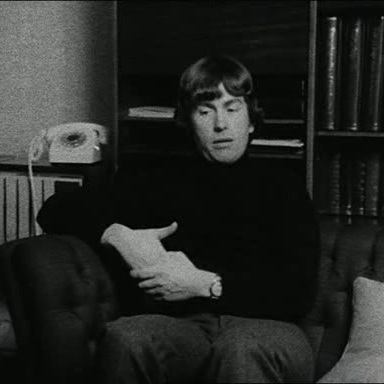
We who have Friends
1970, 50 mins
Looking at position of male homosexuals since l967 Reform Act. (co-directed and produced with Richard Reisz at King’s College London)
A documentary shot on film in London and Leeds in 1969, looking at the situation of – and attitudes to – male homosexuals in the UK two years after the 1967 Reform Act. Contains unique interviews with: the Bill's initiator, Leo Abse; the Editor of the bi-sexual/gay magazine 'Jeremy'; social workers who regard 'gayness' as something to be 'cured'; the only gay man willing to appear on camera at that time (despite a comprehensive advertising campaign for candidates); vox pop taken in Leeds market and the East End of London. Location shooting in late 1960’s Leeds, Smithfield Market, at a nude male photo shoot for 'Jeremy' and at a fashion show in Carnaby Street. Sound interviews with gay men still firmly in the closet include a Smithfield meat market worker and a member of the gay Anglican community centred in High Holborn. The film was made independently but slated by the BBC to be broadcast. At the last minute, the Beeb backed out and did not show its first documentary on the subject (made in-house) until four years later. Co-director Richard Reisz went on to work for the BBC, amongst other things as Producer of Tomorrow’s World. Richard Woolley went on to make experimental and fiction films.
GENERAL INFORMATION
Company: Reisz/Woolley
Country: United Kingdom
Type: 16mm Black & White Documentary
Topic: Male homosexuality in late 1960’s Britain
Available as: DVD of cutting copy and mixed master only.
Available from: Yorkshire Film Archive (yfa@yorksj.ac.uk)
CREW
Director: Richard Woolley & Richard Reisz
Camera: David Smith
Sound: Philip Boxer
Editing: Richard Woolley, Richard Reisz
Archiving and digitisation in association with:


DVDs of selected films available. Viewing copies of other work not issued on DVD may be obtained on request from the Yorkshire Film Archive at: yfa@yorksj.ac.uk



